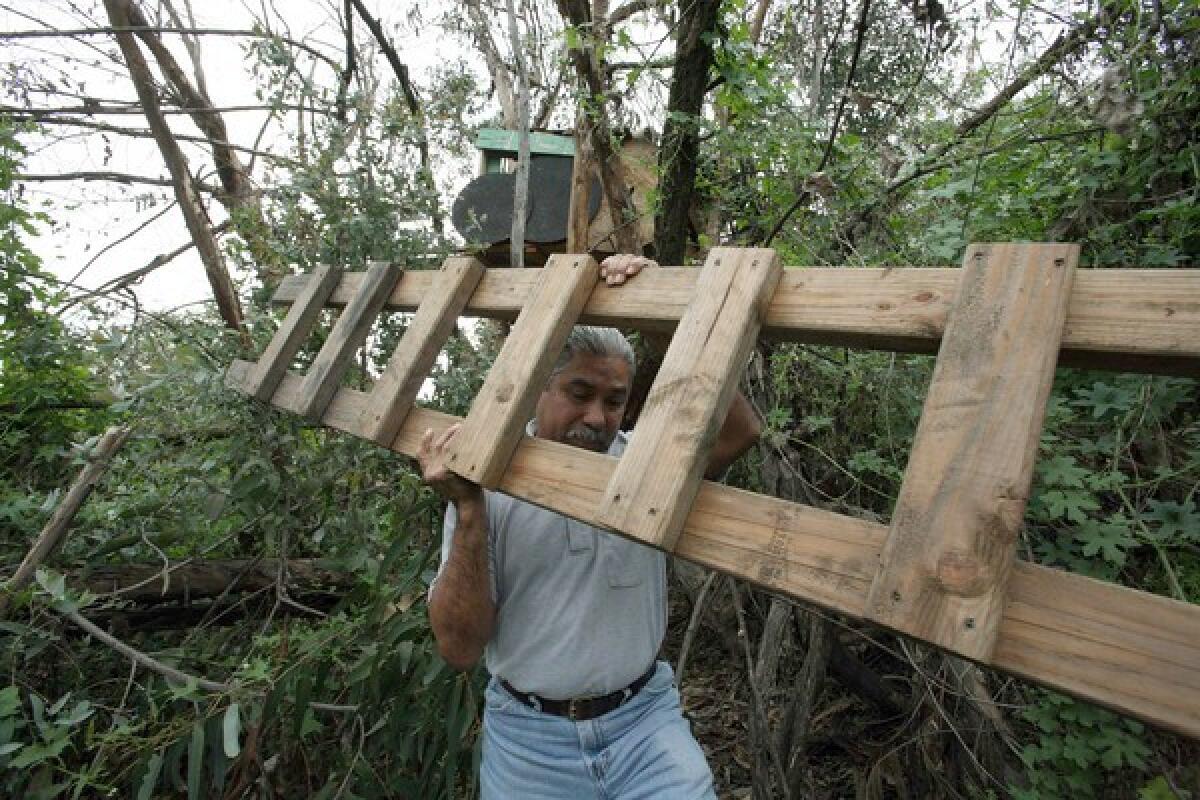Mystery builder leaves a treehouse with a view in Elysian Park

- Share via
Christine Peters was hiking in Elysian Park a few months ago when she spotted a blue tarp amid the treetops. It looked to her like part of a makeshift dwelling.
As the president of the Citizens Committee to Save Elysian Park, Peters knew that such dwellings are common in the park, where on winter nights up to two dozen homeless people sleep in illegal campsites scattered across the hills. She also knew that an errant campfire could send the park up in flames. So she called park police, who promised to look into it.
When park deputies investigated earlier this week, they found a shanty like none they had ever seen.
It was a treehouse, suspended 10 feet up, in the canopy of a eucalyptus.
And even in Elysian Park, where transients have been known to carve houses out of hills and build elaborate lean-tos with mattresses, toilets and -- once -- a working television with a rabbit-ear antenna, this was unusual.
On Tuesday morning, Laura Towels, who has worked in the park as a caretaker and gardener for 28 years, tramped down a grassy, rain-slick embankment off Elysian Park Drive to check out the remarkable treehouse for herself.
Towels had been put in charge of demolishing the structure, and she needed to see what she was up against. She wasn’t sure whether anyone would be inside -- it was vacant when police visited a few days earlier to leave a notice that the structure soon would be destroyed. As a precaution, she asked Juan Garcia, one of her colleagues at the city’s Department of Recreation and Parks, to join her.
Towels and Garcia, armed with sledgehammers, dismantle homeless camps in Elysian Park every Tuesday and Thursday. They have carted away hundreds of garbage bags filled with people’s clothing, pots and pans, radios, playing cards, stuffed animals and toothbrushes.
Destroying a stranger’s home and throwing out their possessions can be tough.
“It hurts me once in a while,” Towels said. “That’s all they have.”
And it can be dangerous.
Last week Towels and Garcia tried to clear a camp when its owner was still there. He “went radical,” Garcia said, and began yelling and threatening to hit the park staff before park police arrested him.
Nearly every park in Los Angeles attracts homeless people, officials with the parks department say, but Elysian Park is especially popular because it is close to downtown and its 600 acres offer transients plenty of hiding places.
Most park residents, officials say, are either homeless people from skid row or undocumented day laborers from Mexico or Central America who can’t afford housing. The park’s biggest encampment is several miles east of the treehouse, atop what is known as Radio Hill.
A year ago, Towels and others cleaned out all 30 campsites they found there. But many new ones have popped up since.
The people who live there usually leave during the day, Towel said, and can often be seen winding their way up overgrown paths in the late afternoon, returning to what they call home.
At one site, someone has carved out a bed of dirt beneath an oak tree and layered it with blankets of cardboard and tarp. A plastic bag filled with food hangs from a branch, out of reach of the coyotes known to roam these parts. In the crook of another branch rests a wet, worn Bible, written in Spanish.
Before Towels and Garcia made the trek out to the treehouse, park staff had been trading theories on its origins. Some thought it had probably been built high to avoid mudslides. Others said it must have been made by someone with something to hide.
Everyone agreed that the architect had to have been pretty strong. The trek down to the tree with the house in it was not an easy one.
When they arrived at a clearing and looked up, Towels and Garcia said they were impressed.
Built about halfway up the large eucalyptus tree, the structure -- a floor, roof, and three walls -- was made out of plywood and pegboard and was held together with screws.
A ladder leaned against the trunk. But it led to a padlocked trap door, which blocked entrance from below.
Garcia managed to get inside by shimmying up a branch of the tree and entering from the side.
Inside, a brightly-painted folk art skeleton hung from the ceiling, and a Mexican blanket was neatly folded in a corner.
The view from up there was unbeatable. To the west stretched acres of lush greenery.
Someone had clearly been enjoying it. Near the open side of the treehouse sat two Perrier bottles stuffed with cigarette butts.
“It must be a hangout place for teenagers,” Garcia told Towels after he scrambled back down. “It’s probably where they party.”
Then he heaved the ladder onto one shoulder to carry it away, and the two trudged up the hill and back to work.
They said they would return Thursday to finish the job.
More to Read
Sign up for Essential California
The most important California stories and recommendations in your inbox every morning.
You may occasionally receive promotional content from the Los Angeles Times.














